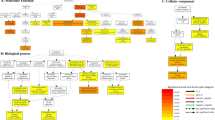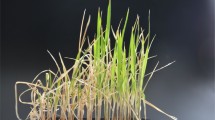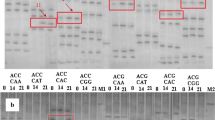Abstract
In this study, we constructed a 22k wheat oligo-DNA microarray. A total of 148,676 expressed sequence tags of common wheat were collected from the database of the Wheat Genomics Consortium of Japan. These were grouped into 34,064 contigs, which were then used to design an oligonucleotide DNA microarray. Following a multistep selection of the sense strand, 21,939 60-mer oligo-DNA probes were selected for attachment on the microarray slide. This 22k oligo-DNA microarray was used to examine the transcriptional response of wheat to salt stress. More than 95% of the probes gave reproducible hybridization signals when targeted with RNAs extracted from salt-treated wheat shoots and roots. With the microarray, we identified 1,811 genes whose expressions changed more than 2-fold in response to salt. These included genes known to mediate response to salt, as well as unknown genes, and they were classified into 12 major groups by hierarchical clustering. These gene expression patterns were also confirmed by real-time reverse transcription-PCR. Many of the genes with unknown function were clustered together with genes known to be involved in response to salt stress. Thus, analysis of gene expression patterns combined with gene ontology should help identify the function of the unknown genes. Also, functional analysis of these wheat genes should provide new insight into the response to salt stress. Finally, these results indicate that the 22k oligo-DNA microarray is a reliable method for monitoring global gene expression patterns in wheat.





Similar content being viewed by others
References
Avsian-Kretchmer O, Gueta-Dahan Y, Lev-Yadun S, Gollop R, Ben-Hayyim G (2004) The salt-stress signal transduction pathway that activates the gpx1 promoter is mediated by intracellular H2O2, different from the pathway induced by extracellular H2O2. Plant Physiol 135:1685–1696
Bennett M, Smith J (1976) Nuclear DNA amounts in angiosperms. Philos Trans R Soc Lond B274:227–274
Bennetzen JL, Coleman C, Liu R, Ma J, Ramakrishna W (2004) Consistent over-estimation of gene number in complex plant genomes. Curr Opin Plant Biol 7:732–736
Chinnusamy V, Schumaker K, Zhu J (2004) Molecular genetic perspectives on cross-talk and specificity in abiotic stress signalling in plants. J Exp Bot 55:225–236
Conley E et al (2004) A 2600-locus chromosome bin map of wheat homoeologous group 2 reveals interstitial gene-rich islands and colinearity with rice. Genetics 168:625–637
Eisen M, Spellman P, Brown P, Botstein D (1998) Cluster analysis and display of genome-wide expression patterns. Proc Natl Acad Sci U S A 95:14863–14868
Feuillet C, Keller B (2002) Comparative genomics in the grass family: molecular characterization of grass genome structure and evolution. Ann Bot 89:3–10
Halfter U, Ishitani M, Zhu JK (2000) The Arabidopsis SOS2 protein kinase physically interacts with and is activated by the calcium-binding protein SOS3. Proc Natl Acad Sci U S A 97:3735–3740
Karlin S, Altschul SF (1993) Applications and statistics for multiple high scoring segments in molecular sequences. Proc Natl Acad Sci U S A 90:5873–5877
Kawasaki S, Borchert C, Deyholos M, Wang H, Brazille S, Kawai K, Galbraith D, Bohnert H (2001) Gene expression profiles during the initial phase of salt stress in rice. Plant Cell 13:889–905
Kikuchi S et al (2003) Collection, mapping, and annotation of over 28,000 cDNA clones from japonica rice. Science 301:376–379
Kim JY, Mahe A, Brangeen J, Drioul JL (2000) A maize vacuolar invertase, IVR2, is induced by water stress, organ/tissue specificity and diurnal modulation of expression. Plant Physiol 124:71–84
Kimura M, Yamamoto Y, Seki M, Sakurai T, Sato M, Abe T, Yoshida S, Manabe K, Shinozaki K, Matsui M (2003) Identification of Arabidopsis genes regulated by high light-stress using cDNA microarray. Photochem Photobiol 77:226–233
Kreps J, Wu Y, Chang H, Zhu T, Wang X, Harper J (2002) Transcriptome changes for Arabidopsis in response to salt, osmotic, and cold stress. Plant Physiol 130:2129–2141
La Rota M, Sorrells ME (2004) Comparative DNA sequence analysis of mapped wheat ESTs reveals the complexity of genome relationships between rice and wheat. Funct Integr Genomics 4:34–46
Lazo GR et al (2004) Development of an expressed sequence tag (EST) resource for wheat (Triticum aestivum L.): EST generation, unigene analysis, probe selection and bioinformatics for 16,000-locus bin-delineated map. Genetics 168:585–593
Linkiewicz A et al (2004) A 2500-locus bin map of wheat homoeologous group 5 provides insights on gene distribution and colinearity with rice. Genetics 168:665–676
Liu J, Zhu JK (1997) An Arabidopsis mutant that requires increased calcium for potassium nutrition and salt tolerance. Proc Natl Acad Sci U S A 94:14960–14964
Mochida K, Yamazaki Y, Ogihara Y (2003) Discrimination of homoeologous gene expression in hexaploid wheat by SNP analysis of contigs grouped from a large number of expressed sequence tags. Mol Genet Genomics 270:371–377
Mockler T, Ecker J (2005) Applications of DNA tiling arrays for whole-genome analysis. Genomics 85:1–15
Mundy J, Chua N-H (1988) Abscisic acid and water-stress induce the expression of a novel rice gene. EMBO J 7:2279–2286
Nemoto Y, Sasakuma T (2002) Differential stress responses of early salt-stress responding genes in common wheat. Phytochemistry 61:129–133
Ogihara Y, Mochida K, Nemoto Y, Murai K, Yamazaki Y, Shin-I T, Kohara Y (2003) Correlated clustering and virtual display of gene expression patterns in the wheat life cycle by large-scale statistical analyses of expressed sequence tags. Plant J 33:1001–1011
Ogihara Y et al (2004) Construction of a full-length cDNA library from young spikelets of hexaploid wheat and its characterization by large-scale sequencing of expressed sequence tags. Genes Genet Syst 79:227–232
Oka HI (1988) Origin of cultivated rice. Elsevier, Amsterdam
Oono Y et al (2003) Monitoring expression profiles of Arabidopsis gene expression during rehydration process after dehydration using a 7000 full-length cDNA microarray. Plant J 34:868–887
Osato N et al (2003) Antisense transcripts with rice full-length cDNAs. Genome Biol 5:R5
Ozkan H, Levy A, Feldman M (2001) Allopolyploidy-induced rapid genome evolution in the wheat (Aegilops–Triticum) group. Plant Cell 13:1735–1747
Peng J et al (2004) Chromosome bin map of expressed sequence tags in homoeologous group 1 of hexaploid wheat and homoeology with rice and Arabidopsis. Genetics 168:609–623
Rabbani M, Maruyama K, Abe H, Khan M, Katsura K, Ito Y, Yoshiwara K, Seki M, Shinozaki K, Yamaguchi-Shinozaki K (2003) Monitoring expression profiles of rice genes under cold, drought, and high-salinity stresses and abscisic acid application using cDNA microarray and RNA gel-blot analyses. Plant Physiol 133:1755–1767
Rhee S et al (2003) The Arabidopsis Information Resource (TAIR): a model organism database providing a centralized, curated gateway to Arabidopsis biology, research materials and community. Nucleic Acids Res 31:224–228
Rossel J, Wilson I, Pogson B (2002) Global changes in gene expression in response to high light in Arabidopsis. Plant Physiol 130:1109–1120
Saijo Y, Hata S, Kyozuka J, Shimamoto K, Izui K (2000) Over-expression of a single Ca2dependent protein kinase confers both cold and salt/drought tolerance on rice plants. Plant J 23:319–327
Sasaki T (2003) Rice genome analysis: understanding the genetic secrets of the rice plant. Breed Sci 53:281–289
Sasaki T et al (2002) The genome sequence and structure of rice chromosome 1. Nature 420:312–316
Seki M et al (2002a) Functional annotation of a full-length Arabidopsis cDNA collection. Science 296:141–145
Seki M et al (2002b) Monitoring the expression pattern of around 7,000 Arabidopsis genes under ABA treatments using a full-length cDNA microarray. Funct Integr Genomics 2:282–291
Seki M et al (2002c) Monitoring the expression profiles of 7000 Arabidopsis genes under drought, cold and high-salinity stresses using a full-length cDNA microarray. Plant J 31:279–292
Seki M et al (2004) RIKEN Arabidopsis full-length (RAFL) cDNA and its applications for expression profiling under abiotic stress conditions. J Exp Bot 55:213–223
Singh N et al (2004) Sequence analysis of the long arm of rice chromosome 11 for rice–wheat synteny. Funct Integr Genomics 4:102–117
Sorrells M et al (2003) Comparative DNA sequence analysis of wheat and rice genomes. Genome Res 13:1818–1827
Stoughton RB (2005) Applications of DNA microarrays in biology. Ann Rev Biochem 74:53–82
Sugimoto M, Okada Y, Sato K, Ito K, Takeda K (2003) A root-specific O-methyltransferase gene expressed in salt-tolerant barley. Biosci Biotechnol Biochem 67:966–972
Takahashi S et al (2004) Monitoring the expression profiles of genes induced by hyperosmotic, high salinity, and oxidative stress and abscisic acid treatment in Arabidopsis cell culture using a full-length cDNA microarray. Plant Mol Biol 56:29–55
Teige M, Scheikl E, Eulgem T, Doczi R, Ichimura K, Shinozaki K, Dangl J, Hirt H (2004) The MKK2 pathway mediates cold and salt stress signaling in Arabidopsis. Mol Cell 15:141–152
The Arabidopsis Genome Initiative (2000) Analysis of the genome sequence of the flowering plant Arabidopsis thaliana. Nature 408:796–815
Thimm O, Essigmann B, Kloska S, Altmann T, Buckhout T (2001) Response of Arabidopsis to iron deficiency stress as revealed by microarray analysis. Plant Physiol 127:1030–1043
Tsugane K, Kobayashi K, Niwa Y, Ohba Y, Wada K, Kobayashi H (1999) A recessive Arabidopsis mutant that grows photoautotrophically under salt stress shows enhanced active oxygen detoxification. Plant Cell 11:1195–1206
Wang H, Miyazaki S, Kawai K, Deyholos M, Galbraith D, Bohnert H (2003) Temporal progression of gene expression responses to salt shock in maize roots. Plant Mol Biol 52:873–891
Wortman J et al (2003) Annotation of the Arabidopsis genome. Plant Physiol 132:461–468
Wu SJ, Lei D, Zhu JK (1996) SOS1, a genetic locus essential for salt tolerance and potassium acquisition. Plant Cell 8:617–627
Xiong L, Schumaker KS, Zhu J-K (2002) Cell signaling during cold, drought, and salt stress. Plant Cell S165–S183
Yamada H et al (2003) Valuatin of 22K rice oligo microarray system for expression analysis of rice genes. The 26th Annual Meeting of the Molecular Biology Society of Japan (Abstract, p 807)
Yamaguchi T, Nakayama K, Hayashi T, Yazaki J, Kishimoto N, Kikuchi S, Koike S (2004) cDNA microarray analysis of rice anther genes under chilling stress at the microsporogenesis stage revealed two genes with DNA transposon castaway in the 5′-flanking region. Biosci Biotechnol Biochem 68:1315–1323
Yamaguchi-Shinozaki K, Shinozaki K (1994) A novel cis-acting element in an Arabidopsis gene in involved in responsiveness to drought, low-temperature, or high-salt stress. Plant Cell 6:251–262
Yamaguchi-Shinozaki K, Mundy J, Chua N-H (1989) Four tightly linked rab genes are differentially expressed in rice. Plant Mol Biol 14:29–39
Yazaki J et al (2003) Genomics approach to abscisic acid- and gibberellin-responsive genes in rice. DNA Res 10:249–261
Yazaki J, Kojima K, Suzuki K, Kishimoto N, Kikuchi S (2004) The Rice PIPELINE: a unification tool for plant functional genomics. Nucleic Acids Res 32:D383–D387
Yu J et al (2002) A draft sequence of the rice genome (Oryza sativa L. ssp. indica). Science 296:79–92
Zhang et al (2004) Construction and evaluation of cDNA libraries for large-scale expressed sequence tag sequencing in wheat (Triticum aestivum L.). Genetics 168:595–608
Zhu JK, Liu J, Xiong L (1998) Genetic analysis of salt tolerance in Arabidopsis thaliana: evidence of a critical role for potassium nutrition. Plant Cell 10:1181–1192
Zohary D, Hopf M (2001) Domestication of plants in the old world. Oxford University Press, New York
Acknowledgements
This work was supported by Grants-in-Aid for Scientific Research on Priority Areas (C) “Genome Science” (No. 13202055) and the National Bioresource Project of the Ministry of Education, Culture, Sports, Science, and Technology of Japan.
Data obtained from the present microarray experiments have been deposited to the public site: http://www.shigen.nig.ac.jp/wheat/komugi/array/.
Author information
Authors and Affiliations
Corresponding author
Electronic supplementary materials
Rights and permissions
About this article
Cite this article
Kawaura, K., Mochida, K., Yamazaki, Y. et al. Transcriptome analysis of salinity stress responses in common wheat using a 22k oligo-DNA microarray. Funct Integr Genomics 6, 132–142 (2006). https://doi.org/10.1007/s10142-005-0010-3
Received:
Revised:
Accepted:
Published:
Issue Date:
DOI: https://doi.org/10.1007/s10142-005-0010-3




